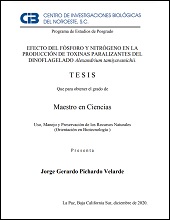| dc.contributor.advisor | ESTRADA MUÑOZ, NORMA ANGELICA | |
| dc.contributor.advisor | Alonso Rodríguez, Rosalba | |
| dc.contributor.author | Pichardo Velarde, Jorge Gerardo | |
| dc.date.issued | 2021 | |
| dc.identifier | https://cibnor.repositorioinstitucional.mx/jspui/handle/1001/2123 | |
| dc.identifier.uri | http://dspace.cibnor.mx:8080/handle/123456789/3086 | |
| dc.description.abstract | "Alexandrium tamiyavanichii es un dinoflagelado marino productor de toxinas paralizantes (TP), que afecta a diversos organismos. Se han caracterizado 57 análogos de las TP entre los que destacan la saxitoxina (STX) y las gonyautoxinas (GTX). Los dinoflagelados aumentan la producción de TP y en algunas ocasiones la síntesis de análogos de mayor potencia tóxica en condiciones de estrés, tal como la limitación de fósforo (LF) y/o exceso de nitrógeno (EN). El objetivo del presente trabajo fue evaluar el crecimiento poblacional y la producción de TP en cultivos de A. tamiyavanichii aislado de la bahía de La Paz, en condiciones de LF y EN. Asimismo, se evaluó la dinámica de los nutrientes en el medio de cultivo a lo largo de la curva de crecimiento. Se cultivó a A. tamiyavanichii en medio GSe con diferentes condiciones de nutrientes: 1) medio GSe sin modificaciones (control), 2) LF y 3) EN. Se realizaron muestreos cada tercer día para evaluar la concentración celular, analizar los nutrientes disueltos en el medio de cultivo (nitritos, nitratos, amonio y ortofosfatos, por técnicas colorimétricas), así como, identificar y cuantificar las TP por medio del método oficial AOAC 2005.06 (HPLC-FLD). Se realizó una curva de crecimiento de 33 días a 24°C ± 0.3°C; 100 µmoles de fotones m-2 s-1; 12 h luz:12 h oscuridad. La fase estacionaria de la curva de crecimiento estuvo ausente en todos los tratamientos. El crecimiento poblacional en el tratamiento LF, provocó un aumento de 3.4 veces la concentración celular con respecto al control y EN (p<0.05). No se encontraron diferencias significativas entre el crecimiento en el control y EN (p>0.05). La mayor concentración de toxinas resultó en el control, el día 21 (309 fmol PSP cél-1), que corresponde a la fase exponencial. No se encontraron diferencias significativas en la producción de toxinas en los tratamientos propuestos con respecto al control (p>0.05). La SXT fue el análogo que se encontró en mayor proporción en todos los tratamientos (>40%) y en todos los días de muestreo. Aun cuando al tratamiento de LF no se le adicionó ortofosfato, se determinaron concentraciones superiores al agua de mar utilizada en el cultivo. Se concluye que los tratamientos de LF y EN no afectaron la producción de TP de A. tamiyavanichii, solo la LF promovió el crecimiento poblacional del dinoflagelado con respecto al control..." | es |
| dc.format | pdf | es |
| dc.language.iso | spa | es |
| dc.publisher | Centro de Investigaciones Biológicas del Noroeste, S.C. | es |
| dc.rights | Acceso abierto | es |
| dc.subject | Alexandrium tamiyavanichii, exceso de nitrógeno, limitación de fósforo, nutrientes, toxinas paralizantes | es |
| dc.subject | Alexandrium tamiyavanichii, nitrogen excess, phosphorus limitation, nutrients, paralyzing toxins | es |
| dc.subject.classification | ALGOLOGÍA (FICOLOGÍA) | es |
| dc.title | Efecto del fósforo y nitrógeno en la producción de toxinas paralizantes del dinoflagelado Alexandrium tamiyavanichii. | es |
| dc.type | masterThesis | es |
| dc.dirtesis.grado | Maestría en Ciencias en el Uso, Manejo y Preservación de los Recursos Naturales | es |
| dc.dirtesis.disciplina | Biotecnología | es |
| dc.dirtesis.universidad | Centro de Investigaciones Biológicas del Noroeste, S.C. | es |
| dc.dirtesis.facultad | Posgrado en Recursos Naturales | es |
| dc.description.abstracten | "Alexandrium tamiyavanichii is a marine dinoflagellate that produces paralyzing toxins (PT), which affects various organisms. More than 57 analogs have been characterized, among which the saxitoxin (STX) and the gonyautoxins (GTX) stand out. Dinoflagellates increase the production of TP and, on some occasions, the synthesis of analogs of higher toxic potency under stress conditions, such as the limitation of phosphorus (LF) and/or excess nitrogen (EN). This work aimed to evaluate the population growth and TP production in cultures of A. tamiyavanichii isolated from the Bay of La Paz under conditions of LF and EN. Likewise, the dynamic of the nutrients in the culture medium was evaluated along the growth curve. A. tamiyavanichii was grown in GSe medium with different nutrient conditions: 1) GSe medium without modifications (control), 2) LF, and 3) EN. Samples were carried out every third day to evaluate the cell concentration, analyze the nutrients dissolved in the culture medium (nitrites, nitrates, ammonium, and orthophosphates, by colorimetric techniques), as well as, identify and quantify the TP through the official method AOAC 2005.06 (HPLC-FLD). A growth curve of 33 days was made at 24 ° C ± 0.3 ° C; 100 µmol of photons m-2 s-1; 12 h light: 12 h dark. The stationary phase of the growth curve was absent in all treatments. The stationary phase of the growth curve was absent in all treatments. The population growth in the LF treatment caused an increase of 3.4 times the cell concentration concerning the control and EN (p <0.05). No significant differences were found between growth in control and EN (p> 0.05). The highest concentration of toxins resulted in the control on day 21 (309 fmol PSP cell-1), which corresponds to the exponential phase. No significant differences were registered in toxins production in the proposed treatments concerning the control (p> 0.05). SXT was the analog found in the highest proportion in all treatments (> 40%) and all sampling days. Even when orthophosphate was not added to the LF treatment, concentrations higher than the seawater used in the culture were determined. It is concluded that the LF and EN treatments did not affect the production of PT of A. tamiyavanichii; only the LF promoted the population growth of the dinoflagellate concerning the control..." | es |

